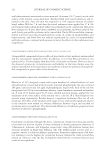DISINFECTION OF REUSABLE MAKE-UP APPLICATORS 167 DISCUS SION The co nducted analyses show that all the agents used in the study—antibacterial soap, medical spirit, and the solution for disinfecting tools and surfaces—show different effec- tiveness in disinfecting reusable make-up applicators. The effectiveness of disinfection not only depends on the type of applicator but also on the type of product being applied. The re search is not without restrictions. It was only bacterial contamination that was considered in the study, with viral contamination not being assessed. The hygiene proce- dures in a beauty salon and the level of knowledge of the medical staff were also not Figure 2. Impact of disinfectants on the natural make-up brush before disinfection (A) and after disinfection (B). Legende: #1: control test #2: water #3: soap #4: ethanol, 30 s #5: ethanol, 3 min #6: re-disinfection after using, 30 s #7: re-disinfection after using, 3 min. Figure 3. Impact of disinfectants on the synthetic make-up brush before disinfection (A) and after disinfection (B). Legende: #1: control test #2: water #3: soap #4: ethanol, 30 s #5: ethanol, 3 min #6: re-disinfection after using, 30 s #7: re-disinfection after using, 3 min.
JOURNAL OF COSMETIC SCIENCE 168 evaluated. Therefore, the study provides information on the part of the process by assess- ing and comparing the use of the three agents when applying makeup. Litera ture reports indicate that there are differences in the effect of disinfectants (5,6), but only a few of the studies focus on disinfection in beauty salon. Differences in the effect of aseptic agents were noted by Ziembińska and Szpindor, who compared the effectiveness of disinfectants (3% solution of hydrogen peroxide, 2% solution of salicylic alcohol, 3% solution of iodine, and 0.05% solution of potassium permanganate) in removing micro- organisms isolated from the epidermis (7). The effectiveness of the aforementioned solu- tions were characterized after interpreting the number of microorganisms present before and after their use when compared with the control sample. The use of these agents sig- nifi cantly reduced the number of microorganisms. The most effective solution was iodine, which completely eliminated them, whereas the potassium permanganate solution showed the weakest effect. The concentration of the tested agent also affected the results. In high concentrations, these agents have a strong antibacterial effect, but this is associ- ated with possible skin irritation. Gluszek et al. (8) compared the effects of hydrogen peroxide, ethanol, and iodophore with different concentrations and duration of action on S. aureus strains. The tested material included medical materials obtained from hospital patients. The study showed that ethyl alcohol did not reveal its bactericidal properties at a concentration of 60% for any of the tested times (15 s, 1 min, and 2 min) however, in a concentration of 70%, it stopped the development of 47 isolated strains in 1 minute. In turn, the disinfecting action of iodophore was effective at its low concentrations. The 1% concentration of iodophore, which is recommended in antiseptics, reduced the growth of 100% of strains in 1 minute. The effi ciency of hydrogen peroxide increased with an in- crease in its concentration. Within 15 s, a complete stop of microbial growth occurred after the application of the 3% solution of hydrogen peroxide. The use of 1 and 2% hy- drogen peroxide for 1 min inhibited the development of 17 and 38 staphylococcal strains, respectively. Breneman et al. (9) examined the effect of antibacterial soap with triclocar- ban at a concentration of 1.5% on the reduction of the number of S. aureus on the skin of Figure 4. Impact of disinfectants on the make-up sponge before disinfection (A) and after disinfection (B). Legende: #1: control test #2: water #3: soap #4: ethanol, 30 s #5: ethanol, 3 min #6: re-disinfection after using, 30 s #7: re-disinfection after using, 3 min.
Purchased for the exclusive use of nofirst nolast (unknown) From: SCC Media Library & Resource Center (library.scconline.org)

























































































































